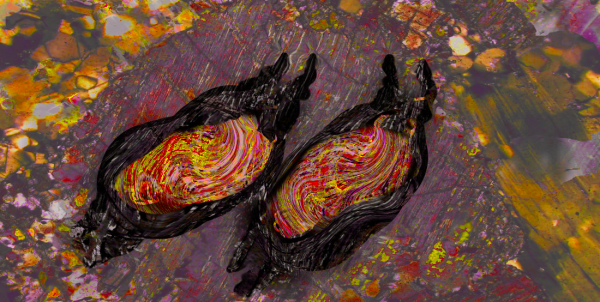BY LETTER
Rheolithoids
High plasticity mineral-based high temperature lifeforms | |
 Image from Steve Bowers | |
| Two rheolithoids inside a body of molten rock on YTS 23541-36622 I, a recently explored world on the Periphery. They are apparently interacting in some way; possibly communicating, fighting or mating. Image created by a geophysical deep scan system. | |
Rheolithoids are a type of non-organic organisms consisting entirely of specialised mineral-like structures, primarily those with high plasticity by definition, but solid and fluid structures are also common. They normally thrive in habitats with abundant magma or lava.
The first rheolithoids were discovered in 2946 AT on Hiloenu, an Io-like world orbiting Dakaki (JD 13188094), a red dwarf ten light years from the giant star Yirn Mhon (HD 2954) in Pisces. A Silicon Generation survey team found evidence of organised structures in certain essential pyroclasts which had been ejected from several equatorial volcanoes. These organised structures resembled living creatures in many ways, although all the examples found were inactive and presumed to be dead.
Seismic data suggested a global magma ocean 5-40 km below the surface, connected to the surface through volcanic pipes. In this environment, rocky material is constantly being processed. Geologists used a lithosphere probe to study these life-like structures. Some of these structures were confirmed to be living organisms, while others were identified to be byproducts of their unique biological processes. The researchers named the new organisms rheolithoids, because of their flowing, plastic nature. They studied these entities for hundreds of years, using a range of geophysical sensors alongside more invasive examinations. Eventually they produced a detailed description of the ecology of the magma ocean and biology of its denizens.
In 3530, another world, Natfaire, was discovered to support more complex rheolithoid-type organisms. Hundreds of magmatic biospheres have been discovered by now, many fairly simple, but some quite complex. The creatures on most such worlds freely thrive on the surface, and have been found to be very different in detail to each other.
The Silicon Generation attempted to recreate a suitable magmatic environment for the Hiloenu rheolithoids on another volcanic world orbiting a star known as Baatnal, succeeding in 3165. Since that time a wide range of modified forms of various lineages of rheolithoids have been developed by various groups across the Terragen Sphere, capable of thriving in several different types of ignean environments. The first provolved intelligent form was eventually developed by 4080, based on a Natfairean species, followed by many more over the millennia. These high-temperature sophonts, known as Cherufes, have become widely distributed in magmatic environments around the Terragen Sphere; they have also found a niche in other high energy environments such as fusion drive cooling systems in the rocket drives of spacecraft.
 Image from Steve Bowers | |
| Two cherufes from the Cloud Hides True Beauty habitat, Oefem system. | |
Example: Hiloenu Rheolithoids
Individual Hiloenu rheolithoids are composed from complicated interwoven siliceous minerals such as kalsilite and melilite, together with numerous impurities such as germanium, selenium and rare-earths. These entities are capable of growth and self-replication, and are generally more than a metre in length.The core of any single organism is a fine-grained nucleus of interwoven minerals, apparently related to a vortex crystal formation, but with a consistent asymmetrical organisation that is recognisably similar from one individual to another. Individuals are usually 0.1 to 10 metres in diameter, and mostly sessile, sometimes moving slowly towards a source of comminuted minerals or to avoid being absorbed by a larger individual. Despite their macroscopic size (common among even simple rheolithoids), Hiloenu organisms are no more complex or self-aware than microbes in an organic biota.
Information for the perpetuation of the organised system is stored in germanium and selenium intercalated in tiny data rich flat plaque minerals, while response to the environment is transmitted by slow oscillating reactions in glassy zeolites regulated by cation inclusions acting as messengers to and from the nucleus. The oscillating reactions cause tiny rotating cells to establish in the semimolten zeolite integument, permitting movement towards or away from stimuli. Hiloenu rheolithoids sense their environment by absorbing fine material between these rotating cells, which is then tested by an array of subcutaneous reactant mineral micrograins. Energy is stored in the rotating cells and in endothermic crystallization reactions.
Related Articles
Appears in Topics
Development Notes
Text by Steve Bowers, updated by The Astronomer, dangerous_safety 2021
Initially published on 20 October 2002.
Lava and magma life is discussed in pages 252-256 of the book Life Beyond Earth: the Intelligent Earthling's Guide to Life in the Universe, available to borrow from the Internet Archive.
Initially published on 20 October 2002.
Lava and magma life is discussed in pages 252-256 of the book Life Beyond Earth: the Intelligent Earthling's Guide to Life in the Universe, available to borrow from the Internet Archive.






